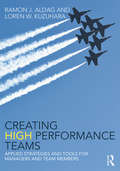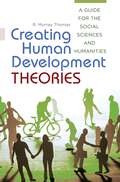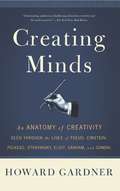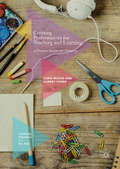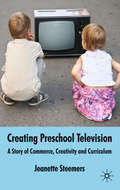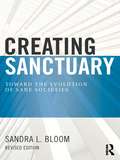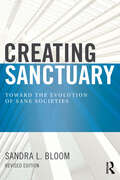- Table View
- List View
Creating Enviromental Policy in the European Union
by A. ZitoInvestigates the EU policy-making process and why this process has taken major steps to advance environmental regulation in some areas and not others. The book develops a framework emphasizing decision-making modes, which provide a more nuanced understanding, compared to traditional EU theoretical approaches, of how EU actors make decisions.
Creating Europe from the Margins: Mobilities and Racism in Postcolonial Europe
by Kristín LoftsdóttirThis edited volume explores the idea of Europe through a focus on its margins. The chapters in the volume inquire critically into the relations and tensions inherent in divisions between the Global North and the Global South as well as internal regional differentiation within Europe itself. In doing so, the volume stresses the need to consider Europe from critical interdisciplinary perspectives, highlighting historical and contemporary issues of racism and colonialism. While recent discussions of migration into ‘Fortress Europe’ seem to assume that Europe has clearly demarcated geographic, political and cultural boundaries, this book argues that the reality is more complex. The book explores margins conceptually and positions margins and centres as open to negotiation and contestation and characterized by ambiguity. As such, margins can be contextualized in relation to hierarchies within Europe, with different processes involved in creating boundaries and borders between different kinds of Europes and Europeans. Deploying case studies from different places, such as Iceland, Italy, Poland, Spain, Turkey, the UK, Romania, Cyprus, Greece, Sicily, European colonies in the Caribbean and the former Yugoslavia, the contributors analyse how different geopolitical hierarchies intersect with racialized subject positions of diverse people living in Europe, while also exploring issues of gender, class, sexuality, religion and nationality. Some chapters draw attention to the fortification of Europe’s ‘borderland,’ while others focus on internal hierarchies within Europe, critiquing the meaning of spatial boundaries in an increasingly digitalized Europe. In doing so, the chapters interrogate the hierarchies at play in the processes of being and becoming ‘European’ and the ongoing impacts of race and colonialism. This timely and thought-provoking collection will be of considerable significance to those in the humanities and social sciences with an interest in Europe. Chapter 11 of this book is freely available as a downloadable Open Access PDF at http://www.taylorfrancis.com under a Creative Commons [Attribution-Non Commercial-No Derivatives (CC-BY-NC-ND)] 4.0 license.
Creating Europe from the Margins: Mobilities and Racism in Postcolonial Europe
This edited volume explores the idea of Europe through a focus on its margins. The chapters in the volume inquire critically into the relations and tensions inherent in divisions between the Global North and the Global South as well as internal regional differentiation within Europe itself. In doing so, the volume stresses the need to consider Europe from critical interdisciplinary perspectives, highlighting historical and contemporary issues of racism and colonialism. While recent discussions of migration into ‘Fortress Europe’ seem to assume that Europe has clearly demarcated geographic, political and cultural boundaries, this book argues that the reality is more complex. The book explores margins conceptually and positions margins and centres as open to negotiation and contestation and characterized by ambiguity. As such, margins can be contextualized in relation to hierarchies within Europe, with different processes involved in creating boundaries and borders between different kinds of Europes and Europeans. Deploying case studies from different places, such as Iceland, Italy, Poland, Spain, Turkey, the UK, Romania, Cyprus, Greece, Sicily, European colonies in the Caribbean and the former Yugoslavia, the contributors analyse how different geopolitical hierarchies intersect with racialized subject positions of diverse people living in Europe, while also exploring issues of gender, class, sexuality, religion and nationality. Some chapters draw attention to the fortification of Europe’s ‘borderland,’ while others focus on internal hierarchies within Europe, critiquing the meaning of spatial boundaries in an increasingly digitalized Europe. In doing so, the chapters interrogate the hierarchies at play in the processes of being and becoming ‘European’ and the ongoing impacts of race and colonialism. This timely and thought-provoking collection will be of considerable significance to those in the humanities and social sciences with an interest in Europe. Chapter 11 of this book is freely available as a downloadable Open Access PDF at http://www.taylorfrancis.com under a Creative Commons [Attribution-Non Commercial-No Derivatives (CC-BY-NC-ND)] 4.0 license.
Creating Fear: News and the Construction of Crisis
by David L. AltheideThe creative use of fear by news media and social control organizations has produced a "discurse of fear" - the awareness and expection that danger and risk are lurking everywhere. Case studies illustrates how certain organizations and social institutions benefit from the explotation of such fear construction. One social impact is a manipulated public empathy: We now have more "victims" than at any time in our prior history. Another, more troubling resutl is the role we have ceded to law enforcement and punishment: we turn ever more readily to the state and formal control to protect us from what we fear. This book attempts through the marshalling of significant data to interrupt that vicious cycle of fear discourse.
Creating Fear: News and the Construction of Crisis
by David L. AltheideThe creative use of fear by news media and social control organizations has produced a "discurse of fear" - the awareness and expection that danger and risk are lurking everywhere. Case studies illustrates how certain organizations and social institutions benefit from the explotation of such fear construction. One social impact is a manipulated public empathy: We now have more "victims" than at any time in our prior history. Another, more troubling resutl is the role we have ceded to law enforcement and punishment: we turn ever more readily to the state and formal control to protect us from what we fear. This book attempts through the marshalling of significant data to interrupt that vicious cycle of fear discourse.
Creating Futures: Leading Change Through Information Systems (Routledge Revivals)
by Andrew Dorac-KakabadseThis title was first published in 2000: This volume focuses on the influence of, and additionally explores the value adding contribution of, information systems and related technologies on the development of society and private and public sector enterprises. The chapters are stand-alone units representing the research work and thinking of the Cranfield School of Management. The initial chapters examine the impact of IS/IT on society and organizations. As the book progresses, attention is then given to exploring the effects of IS/IT on individuals within the information arena and more broadly within varying walks of life.
Creating Futures: Leading Change Through Information Systems (Routledge Revivals)
by Andrew Dorac-KakabadseThis title was first published in 2000: This volume focuses on the influence of, and additionally explores the value adding contribution of, information systems and related technologies on the development of society and private and public sector enterprises. The chapters are stand-alone units representing the research work and thinking of the Cranfield School of Management. The initial chapters examine the impact of IS/IT on society and organizations. As the book progresses, attention is then given to exploring the effects of IS/IT on individuals within the information arena and more broadly within varying walks of life.
Creating Green Citizens: Bildung, Demokratie und der Klimawandel (Kindheit – Bildung – Erziehung. Philosophische Perspektiven)
by Johannes Drerup Franziska Felder Veronika Magyar-Haas Gottfried SchweigerDer Zusammenhang zwischen liberaler Demokratie als Staats- und Lebensform, politischer und ökologischer Bildung und einer angemessenen Einrichtung und Neuausrichtung menschlicher Naturverhältnisse im Lichte des Klimawandels ist nicht zuletzt auf Grund der Bewegung „Fridays for Future“ ein Thema, das in der aktuellen öffentlichen Selbstverständigung dauerpräsent ist. Zugleich ist dieser Konnex mit Grundsatzfragen verbunden, die das Selbstverständnis liberaler Demokratien und ihrer Erziehungs- und Bildungssysteme in ihrem normativen Kern betreffen. In dem Band werden unterschiedliche miteinander verschränkte Problemdimensionen des Zusammenhangs zwischen Bildung, Demokratie und Klimawandel theoretisch und empirisch rekonstruiert, analysiert und diskutiert.
Creating High Performance Teams: Applied Strategies and Tools for Managers and Team Members
by Ray Aldag Loren KuzuharaCreating High Performance Teams is an accessible and thorough new introduction to this key area of business education. Written by teams experts Ray Aldag and Loren Kuzuhara, this book provides students with both a firm grounding in the key concepts of the field and the practical tools to become successful team managers and members. Built on a solid foundation of the most up to date research and theory, chapters are packed with case studies, real-world examples, tasks and discussion questions, while a companion website supports the book with a wealth of useful resources for students, team members, and instructors. Centered around an original model for high performance teams, topics covered include: Building and developing effective teams Managing diversity Effective communication Team processes – meetings, performance management Dealing with change and team problems Current issues – virtual teams, globalization With its combined emphasis on principles and application, interwoven with the tools, topics, and teams most relevant today, Creating High Performance Teams is perfectly placed to equip upper-level undergraduate and MBA students with the knowledge and skills necessary to take on teams in any situation.
Creating High Performance Teams: Applied Strategies and Tools for Managers and Team Members
by Ray Aldag Loren KuzuharaCreating High Performance Teams is an accessible and thorough new introduction to this key area of business education. Written by teams experts Ray Aldag and Loren Kuzuhara, this book provides students with both a firm grounding in the key concepts of the field and the practical tools to become successful team managers and members. Built on a solid foundation of the most up to date research and theory, chapters are packed with case studies, real-world examples, tasks and discussion questions, while a companion website supports the book with a wealth of useful resources for students, team members, and instructors. Centered around an original model for high performance teams, topics covered include: Building and developing effective teams Managing diversity Effective communication Team processes – meetings, performance management Dealing with change and team problems Current issues – virtual teams, globalization With its combined emphasis on principles and application, interwoven with the tools, topics, and teams most relevant today, Creating High Performance Teams is perfectly placed to equip upper-level undergraduate and MBA students with the knowledge and skills necessary to take on teams in any situation.
Creating Human Development Theories: A Guide for the Social Sciences and Humanities
by R. Murray ThomasHow—and why—do humans develop as they do? This book clearly explains the key components of human development theories and describes how to compose novel theories regarding this age-old puzzle.As college students progress through bachelor's degree programs and then advance to their master's degree theses and doctoral dissertations, they are bombarded with studies of countless theories, often adopting some author's theory for interpreting information about human development, even when the theory does not precisely meet their needs. One way to solve the problem—a way especially tuned to the current classroom push for creative, critical thinking—is for the student to create his or her own theory. Unfortunately, even students as high as the doctoral level often don't understand how to create a well-ordered, workable theory of their own—a crucial gap in their "critical thinking" skillsets. This book is the solution to that specific problem. In these pages, in clear and detailed steps, is a complete explanation for developing a theory.The book addresses key topics such as attention to need, population, basic assumptions, key terms, causes and stages, interpreting evidence, and applications. Author R. Murray Thomas—a well-known and highly respected elder in the social sciences—also details five illustrative theories, covering their history and providing insights about how they were developed. This work will be valuable to students of psychology, human development, child development, and theory as well as those in other disciplines seeking an understanding of theory building.
Creating Human Development Theories: A Guide for the Social Sciences and Humanities
by R. Murray ThomasHow—and why—do humans develop as they do? This book clearly explains the key components of human development theories and describes how to compose novel theories regarding this age-old puzzle.As college students progress through bachelor's degree programs and then advance to their master's degree theses and doctoral dissertations, they are bombarded with studies of countless theories, often adopting some author's theory for interpreting information about human development, even when the theory does not precisely meet their needs. One way to solve the problem—a way especially tuned to the current classroom push for creative, critical thinking—is for the student to create his or her own theory. Unfortunately, even students as high as the doctoral level often don't understand how to create a well-ordered, workable theory of their own—a crucial gap in their "critical thinking" skillsets. This book is the solution to that specific problem. In these pages, in clear and detailed steps, is a complete explanation for developing a theory.The book addresses key topics such as attention to need, population, basic assumptions, key terms, causes and stages, interpreting evidence, and applications. Author R. Murray Thomas—a well-known and highly respected elder in the social sciences—also details five illustrative theories, covering their history and providing insights about how they were developed. This work will be valuable to students of psychology, human development, child development, and theory as well as those in other disciplines seeking an understanding of theory building.
Creating Infrastructures for Latino Mental Health
by Lydia P. Buki and Lissette M. PiedraLatinos are the fastest growing and largest minority group in the United States. In 2008, this group numbered over 47 million; by 2050, the population is expected to triple, reaching 133 million. Traditionally, Latinos have immigrated to large urban centers (e.g., New York, Los Angeles) that over long periods of time developed a complex infrastructure to receive new immigrants. Increasingly, new Spanish-speaking immigrants are moving into areas of the country previously unfamiliar to them. Although urban co-ethnic communities continue to be the destination of many newcomers, immigrants from Mexico, Central America, and South America in pursuit of low-skilled labor opportunities are settling in small towns and rural areas of the South and Midwest. This new demographic trend has resulted in the creation of the term "new growth communities," which refers to small rural areas that are now home to a small but rapidly growing Hispanic population. Unfortunately, these communities, which are now present in many states across the country (e.g., Illinois, North Carolina), lack the infrastructure necessary to meet the needs of Latino immigrants (e.g., access to health care, immigration assistance, and breaking down language barriers). The lack of an infrastructure and the lack of an established ethnic community to facilitate the assimilation of new immigrants present an ongoing challenge, especially in the area of Latino mental health. The volume focuses on dealing with systemic issues and on providing innovative ideas for development of infrastructure of services. This text will advance ways to understand and ameliorate mental health disparities both from research and experiential perspectives.
Creating Minds: An Anatomy of Creativity as Seen Through the Lives of Freud, Einstein, Picasso, Stravinsky, Eliot, G
by Howard E. GardnerThis peerless classic guide to the creative self uses portraits of seven extraordinary individuals to reveal the patterns that drive the creative process -- to demonstrate how circumstance also plays an indispensable role in creative success.Howard Gardner changed the way the world thinks about intelligence. In his classic work Frames of Mind, he undermined the common notion that intelligence is a single capacity that every human being possesses to a greater or lesser extent. With Creating Minds, Gardner gives us a path breaking view of creativity, along with riveting portraits of seven figures who each reinvented an area of human endeavor. Using as a point of departure his concept of seven "intelligences," ranging from musical intelligence to the intelligence involved in understanding oneself, Gardner examines seven extraordinary individuals -- Sigmund Freud, Albert Einstein, Pablo Picasso, Igor Stravinsky, T.S. Eliot, Martha Graham, and Mahatma Gandhi -- each an outstanding exemplar of one kind of intelligence. Understanding the nature of their disparate creative breakthroughs not only sheds light on their achievements but also helps to elucidate the "modern era" -- the times that formed these creators and which they in turn helped to define. While focusing on the moment of each creator's most significant breakthrough, Gardner discovers patterns crucial to our understanding of the creative process. Creative people feature unusual combinations of intelligence and personality, and Gardner delineates the indispensable role of the circumstances in which an individual's creativity can thrive -- and how extraordinary creativity almost always carries with it extraordinary human costs.
Creating New Meanings For Old Age: Plans and Projects After Eighty
by Isabella PaolettiThis edited volume proposes a radical change in perspective, fighting the prevalent ageist culture that tends to relegate the oldest old to isolation and irrelevance. The chapters show that having plans and projects, being involved in life, is possible for those aged 80 and over, as well as for oldest old people with disabilities. Exploring the involvement of oldest old people in various activities that make them feel happy, worthy, and connected, this volume builds on a large empirical literature documenting that a sense of purpose in life is associated with delayed mortality and reduced health risks. In doing so, this book aims to combat widespread ageist attitudes at an interactional and institutional level, and shift the focus from loss and decay to adaptability, involvement, inner strength, and resilience. It illuminates how oldest old people are inventing new meanings for ageing.
Creating Organizational Value through Dialogical Leadership: Boiling Rice in Still Water
by Rens Van LoonThis book demonstrates Dialogical Leadership which is the workplace application of the Dialogical Self Theory, first developed by Dutch psychologist Hubert Hermans in the 1990s. It encourages scientists and science-practitioners interested in leadership issues to discuss the power of dialogue in solving workplace culture problems. Van Loon’s work extends the concept of Dialogical Self Theory to the leadership of organizations, drawing on social constructionism by the American psychologist Ken Gergen and the leadership framework of British academic Keith Grint. This book explicitly links the health of organizations to the psychological and emotional health of those who lead them, concluding with the factors of teamwork and motivation. Dialogical Leadership jettisons the idea that organizations are run by ‘superheroes’, presenting a more realistic picture of the workplace. This is the first book to isolate ‘generative dialogue’ as the key mechanism for successful change and transformation programs in organizations. It rejects the idea that successful organizations are ‘rational systems’ conforming to scripts laid down by leaders, and it places dialogue and co-creation – ‘reciprocal exchange’ – at the heart of successful change programs. It starts from the kinds of questions leaders ask themselves – their ‘interior dialogue’ – and the quality of their interactions with others – their external dialogues – which can as shown in this book, be the difference between success and failure.
Creating Performances for Teaching and Learning: A Practice Session for Pedagogy
by Chris Mcrae Aubrey HuberThis book uses the metaphors of practice spaces and practice sessions to demonstrate the connection between creative and performance practices, and critical pedagogy. It offers a conceptual framework for using performance and creative practices as starting points for developing philosophies and practices of teaching that are grounded in aesthetic, creative, and critical approaches to education. The practice sessions for pedagogy presented include a range of creative endeavours, such as performance workshops, musical routines, crafting practices, and writing. By focusing on the critical function of creative practices, the book emphasizes the ways creativity can reveal the relationship between everyday acts, and social and cultural ideologies and structures. Creative practices also present the opportunity for imagining new, more socially just and inclusive, configurations of these relationships. This book is designed for teachers and students interested in critical pedagogy, performance, and creative educational practices.
Creating Performances for Teaching and Learning: A Practice Session for Pedagogy (PDF)
by Chris Mcrae Aubrey HuberThis book uses the metaphors of practice spaces and practice sessions to demonstrate the connection between creative and performance practices, and critical pedagogy. It offers a conceptual framework for using performance and creative practices as starting points for developing philosophies and practices of teaching that are grounded in aesthetic, creative, and critical approaches to education. The practice sessions for pedagogy presented include a range of creative endeavours, such as performance workshops, musical routines, crafting practices, and writing. By focusing on the critical function of creative practices, the book emphasizes the ways creativity can reveal the relationship between everyday acts, and social and cultural ideologies and structures. Creative practices also present the opportunity for imagining new, more socially just and inclusive, configurations of these relationships. This book is designed for teachers and students interested in critical pedagogy, performance, and creative educational practices.
Creating Preschool Television: A Story of Commerce, Creativity and Curriculum
by J. SteemersSmall children are regularly captivated by programmes made especially for them – ranging from classics like Sesame Street to more recent arrivals such as Blues Clues and Teletubbies . This book examines the industry interests behind preschool television, and how commercial, creative and curricular priorities shape and inform what is produced.
Creating Psychologically Healthy Workplaces
by Astrid M. Richardsen Ronald J. BurkeWorkplaces can often be sources of stress, interfering with both job satisfaction and performance. This book explores ways to combat the factors contributing to an unhealthy workplace by building on the advances in positive psychology and organizational scholarship over the last 15 years. Focusing on ground-breaking concepts such as psychological capital, ‘happiness compassion’, virtuousness, support and gratitude, this book offers ways to target and reshape the unhealthy workplace environment. Each chapter provides real-life organizational situations in which companies of all sizes implement strategies that either hinder or successfully create a healthy workplace environment. The world-leading authors identify key causes that reduce employee satisfaction and job performance, offering a range of interventions that can prevent negative experiences to ultimately produce happier workforces and boost productivity. This book will be a vital reference for doctoral students studying the links between work and health as well as faculty studying ways to improve employee well-being. Those on advanced courses in human resource management, organization effectiveness and organizational change will also benefit from the vast array of international insights into a healthy workplace environment.
Creating Resilient Futures: Integrating Disaster Risk Reduction, Sustainable Development Goals and Climate Change Adaptation Agendas
by Stephen Flood Yairen Jerez Columbié Martin Le Tissier Barry O’DwyerThis open access edited volume critically examines a coherence building opportunity between Climate Change Adaptation, the Sustainable Development Goals and Disaster Risk Reduction agendas through presenting best practice approaches, and supporting Irish and international case studies. The Covid-19 pandemic has highlighted existing global inequalities and demonstrated the scope and scale of cascading socio-ecological impacts. The impacts of climate change on our global communities will likely dwarf the disruption brought on by the pandemic, and moreover, these impacts will be more diffuse and pervasive over a longer timeframe. This edited volume considers opportunities to address global challenges in the context of developing resilience as an integrated development continuum instead of through independent and siloed agendas.
Creating Sanctuary: Toward the Evolution of Sane Societies, Revised Edition
by Sandra L BloomCreating Sanctuary is a description of a hospital-based program to treat adults who had been abused as children and the revolutionary knowledge about trauma and adversity that the program was based upon. This book focuses on the biological, psychological, and social aspects of trauma. Fifteen years later, Dr. Sandra Bloom has updated this classic work to include the groundbreaking Adverse Childhood Experiences Study that came out in 1998, information about Epigenetics, and new material about what we know about the brain and violence. This book is for courses in counseling, social work, and clinical psychology on mental health, trauma, and trauma theory.
Creating Sanctuary: Toward the Evolution of Sane Societies, Revised Edition
by Sandra L BloomCreating Sanctuary is a description of a hospital-based program to treat adults who had been abused as children and the revolutionary knowledge about trauma and adversity that the program was based upon. This book focuses on the biological, psychological, and social aspects of trauma. Fifteen years later, Dr. Sandra Bloom has updated this classic work to include the groundbreaking Adverse Childhood Experiences Study that came out in 1998, information about Epigenetics, and new material about what we know about the brain and violence. This book is for courses in counseling, social work, and clinical psychology on mental health, trauma, and trauma theory.
Creating Shared Understanding in Product Development Teams: How to ‘Build the Beginning’
by Louise Møller Christian TollestrupDevelopment projects that span different disciplines and groups often face problems in establishing a shared understanding of the project’s purpose, deliverables, and direction. Creating Shared Understanding in Product Development Teams: How to ‘Build the Beginning’ uses research-based cases from TC Electronic, The Red Cross, Daimler AG, and Copenhagen Living Lab to demonstrate one approach to this problem complex. It shows how prototyping specific physical artifacts can function as drivers and focal points for creating the much needed shared understanding. Encompassing both the participant’s and the facilitator’s point of view, Creating Shared Understanding in Product Development Teams: How to ‘Build the Beginning’ provides both practical examples and theoretical explanation for the process of creating shared understanding. This book provides a toolbox and a practical guide for planning, executing, and facilitating workshops. The result is a clear outline of how to facilitate the creation of physical artifacts that enables and stimulates communication between team members, users, and stakeholders in order to create shared understanding of projects
Creating Shared Value as Future Factor of Competition: Analysis and Empirical Evidence (Wirtschaftsethik in der globalisierten Welt)
by Benedikt von LielBenedikt von Liel provides a theoretical and empirical analysis of the concept of Creating Shared Value (CSV). In the theoretical analysis, the author assesses the uniqueness of the theory of Creating Shared Value by comparing it to other relevant social responsibility concepts. The empirical analysis provides insights from over 60 industry case studies of Creating Shared Value. The assessment includes the influence of geography as well as a range of other relevant external and internal factors. As a result, the author identifies critical success factors for the creation of shared value.





